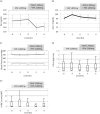The Renoprotective Effects of Docosahexaenoic Acid as an Add-on Therapy in Patients Receiving Eicosapentaenoic Acid as Treatment for IgA Nephropathy: A Pilot Uncontrolled Trial
- PMID: 29093399
- PMCID: PMC5820033
- DOI: 10.2169/internalmedicine.9155-17
The Renoprotective Effects of Docosahexaenoic Acid as an Add-on Therapy in Patients Receiving Eicosapentaenoic Acid as Treatment for IgA Nephropathy: A Pilot Uncontrolled Trial
Abstract
Objective Docosahexaenoic acid (DHA) and eicosapentaenoic acid (EPA) have been reported to have beneficial effects in patients with IgA nephropathy (IgAN). Although DHA and EPA have different mechanisms of action, no study to date has assessed their individual actions in patients with IgAN. This study therefore analyzed the effects administering DHA in addition to EPA for the treatment of IgAN. Methods Twenty-one IgAN patients who were being treated with EPA (1,800 mg/day) were switched to EPA (1,860 mg/day) and DHA (1,500 mg/day). The changes in their clinical parameters from 6 months before to 6 months after switching treatment were analyzed. Results The triglyceride levels did not change during treatment with EPA alone, but tended to decrease-although not to a statistically significant extent-after the switch. The patients' low-density-lipoprotein cholesterol, blood pressure, proteinuria, and hematuria levels were similar before and after switching. The estimated glomerular filtration rate (eGFR) tended to decrease during EPA therapy, but became stable after switching and the median %⊿eGFR changed from -7.354% during EPA therapy to +1.26% during the 6 months after switching to EPA and DHA therapy (p=0.00132), and renal the function remained stable for another 6 months. Moreover, the median %⊿eGFR during the 6 months after switching was significantly higher in comparison to IgAN patients who were treated with EPA alone as a control (-3.26%, p=0.0361). No clinical parameters were independently associated with a stable renal function without switching to DHA/EPA. Conclusion The addition of DHA to EPA stabilized the renal function of IgAN patients, and it seemed that there were pleiotropic effects beyond the improvement of the clinical parameters.
Keywords: IgA nephropathy; docosahexaenoic acid; eicosapentaenoic acid; fish oil; omega-3 polyunsaturated acid.
Figures


Similar articles
-
Effect of fish oil on oxidative stress, lipid profile and renal function in IgA nephropathy.J Med Assoc Thai. 2004 Feb;87(2):143-9. J Med Assoc Thai. 2004. PMID: 15061297
-
Efficacy of omega-3 fatty acids in children and adults with IgA nephropathy is dosage- and size-dependent.Clin J Am Soc Nephrol. 2006 Nov;1(6):1167-72. doi: 10.2215/CJN.02300606. Epub 2006 Sep 27. Clin J Am Soc Nephrol. 2006. PMID: 17699343 Clinical Trial.
-
Lipid effects of switching from prescription EPA+DHA (omega-3-acid ethyl esters) to prescription EPA only (icosapent ethyl) in dyslipidemic patients.Postgrad Med. 2016 Nov;128(8):859-864. doi: 10.1080/00325481.2016.1241129. Epub 2016 Oct 11. Postgrad Med. 2016. PMID: 27684412
-
Eicosapentaenoic Acid Versus Docosahexaenoic Acid as Options for Vascular Risk Prevention: A Fish Story.Am J Ther. 2016 May-Jun;23(3):e905-10. doi: 10.1097/MJT.0000000000000165. Am J Ther. 2016. PMID: 25828517 Review.
-
Effects of eicosapentaenoic acid and docosahexaenoic acid on low-density lipoprotein cholesterol and other lipids: a review.J Clin Lipidol. 2012 Jan-Feb;6(1):5-18. doi: 10.1016/j.jacl.2011.10.018. Epub 2011 Nov 3. J Clin Lipidol. 2012. PMID: 22264569 Review.
Cited by
-
Clinical and histological features and therapeutic strategies for IgA nephropathy.Clin Exp Nephrol. 2019 Sep;23(9):1089-1099. doi: 10.1007/s10157-019-01735-4. Epub 2019 Apr 9. Clin Exp Nephrol. 2019. PMID: 30968243 Review.
-
The Supportive Treatment of IgA Nephropathy and Idiopathic Nephrotic Syndrome: How Useful are Omega-3 Polyunsaturated Fatty Acids?Int J Nephrol Renovasc Dis. 2020 Feb 26;13:27-35. doi: 10.2147/IJNRD.S237527. eCollection 2020. Int J Nephrol Renovasc Dis. 2020. PMID: 32161487 Free PMC article. Review.
-
Dietary Polyunsaturated Fatty Acid Deficiency Impairs Renal Lipid Metabolism and Adaptive Response to Proteinuria in Murine Renal Tubules.Nutrients. 2025 Mar 10;17(6):961. doi: 10.3390/nu17060961. Nutrients. 2025. PMID: 40289946 Free PMC article.
-
Primary IgA nephropathy: current challenges and future prospects.Int J Nephrol Renovasc Dis. 2018 Apr 12;11:137-148. doi: 10.2147/IJNRD.S129227. eCollection 2018. Int J Nephrol Renovasc Dis. 2018. PMID: 29695925 Free PMC article. Review.
References
-
- Berger J, Hinglais N. Intercapillary deposits of IgA-IgG. J Urol Nephrol 74: 694-695, 1968. - PubMed
-
- Komatsu H, Fujimoto S, Hara S, et al. . Recent therapeutic strategies improve renal outcome in patients with IgA nephropathy. Am J Nephrol 30: 19-25, 2009. - PubMed
-
- Philip CC, Purveen Y. Omega-3 polyunsaturated fatty acids and human health outcomes. Biofactors 35: 266-372, 2009. - PubMed
MeSH terms
Substances
LinkOut - more resources
Full Text Sources
Other Literature Sources
Research Materials
Miscellaneous

